When the system says you need to format the disk in drive before you can use it, do not format it yet, as this causes data loss. Follow this MiniTool guide to repair file system errors using CHKDSK or scan and remove viruses with Windows Defender. If all methods fail, recover your files before formatting the drive.
Sometimes, when you try to access your files, your internal or external hard drive says it needs to be formatted, and you cannot open it as usual.

If you click Cancel, you will receive an error message saying that the volume does not contain a recognized file system.

This error means that the operating system detects the disk but cannot recognize or read its file system. In other words, the drive is physically connected but cannot be accessed normally.
Why does the system prompt this error on your drive? Read on to learn the possible reasons.
Why the “You Need to Format the Disk” Message Appears
To be specific, the “you need to format the disk in drive” error can occur due to the following reasons:
- File system corruption. Power failures, unsafe removal, or other errors can damage the file system, preventing the OS from reading it properly.
- Incompatible file system. The disk uses a file system that the current operating system does not support. This makes the system prompt you to format the disk.
- Partition table damage. The partition table stores important information about your disk partitions. If it is corrupted, the disk may appear as unformatted.
- Bad sectors. If bad sectors occur in critical areas of the file system, the operating system may fail to recognize the disk correctly.
- Driver or interface issues. A faulty USB port, cable, disk interface, or driver problem may cause the disk to be detected incorrectly.
- Virus/malware infection. Some viruses can tamper with the partition table or file system information, making the disk inaccessible.
After understanding what the “you need to format the disk in drive” prompt means, let’s see how to fix it without losing your files.
How to Fix “You Need to Format the Disk” on Windows
Want a quick tutorial? Check out this short video:
When prompted to format the disk, DO NOT format it yet. Formatting at this stage will delete all files on the disk and make data recovery much more difficult.
Before formatting, try simple solutions:
- Reconnect the disk or run a CHKDSK repair to fix potential logical errors.
- Run a virus scan to remove any malware and restore the disk to normal.
If you eventually have to format the disk, recover files first to prevent permanent data loss.
Now, follow the solutions below step by step.
Fix 1. Reconnect the Disk
When your internal or external disk prompts that it needs to be formatted, rule out connection issues first of all.
For an external hard drive or removable disk:
- Unplug the disk and reconnect it to your computer.
- If possible, try a different USB port, USB cable, or card reader, and check if the disk becomes accessible.
For an internal hard drive:
- Shut down the computer first.
- Open the case and make sure the SATA and power cables are properly connected to both the hard drive and the motherboard.
- If possible, try reconnecting the disk to a different SATA port on the motherboard.
Sometimes, a simple reconnection can fix the problem. If it does not, try the next solution.
Fix 2. Run CHKDSK
CHKDSK is a command-line tool used to check and repair file system errors and bad sectors. Many users have reported that running CHKDSK resolves the disk formatting error.
How to run CHKDSK? Here are the steps.
Step 1. Run Command Prompt as Administrator
Input cmd in Windows search. Then, right-click Command Prompt and choose Run as administrator.
Step 2. Run CHKDSK [Drive Letter]: /f
In the command line window, type CHKDSK [drive letter]: /f and press Enter.
- The /f parameter is used to repair file system errors on the disk.
- You need to replace the [drive letter] section with the actual drive letter of the problematic disk.
For example, to repair the M: drive, input CHKDSK M: /f and hit Enter.

Once done, go to File Explorer and check if the disk is back to normal. If not, execute CHKDSK with the /r parameter.
Step 3. Run CHKDSK [Drive Letter]: /r
Input CHKDSK [drive letter]: /r and press Enter.
The /r parameter is used to scan for bad sectors, mark them, and attempt to recover readable information. It includes the functionality of /f and is more thorough than /f.
In many cases, running CHKDSK can restore the disk to normal. However, sometimes you may receive an error message saying that CHKDSK is not available for RAW drives.
This happens because CHKDSK cannot repair a drive with a RAW file system. If this is your case, proceed to the methods below.
Fix 3. Scan for Malware/Viruses
Malware or viruses can damage the disk’s file system and prevent the drive from being accessed.
Performing a thorough malware scan is a reliable way to ensure that the issue is not caused by malicious software before formatting the disk.
How to scan your disk for viruses or malware? Use the built-in Windows Defender.
Step 1. Open Windows Security
Press Windows + I to open Settings. Then select Update & Security > Windows Security.
Step 2. Access Scan Options
In the Windows Security tab, click Virus & threat protection. Then click Scan options.
Step 3. Scan for Viruses
Choose a scan method from Quick scan, Full scan, Custom scan, and Microsoft Defender Offline scan, and then hit Scan now.

Wait for the virus scan process to complete. Once done, you can review the scan results to see if any threats were detected.
If Windows Defender finds malware or suspicious files, follow the recommended actions to quarantine or delete them.
If the disk formatting error persists after performing a virus scan, try the last resort – format the disk.
Fix 4. Format the Disk
As the error message suggests, formatting the disk is the most effective way to fix the disk not formatting error. If all other solutions fail, formatting may be necessary.
However, to prevent data loss, recover your files from the disk first by using free data recovery software before proceeding with formatting.
Follow the instructions below to safely recover your files.
Action 1. Recover Files From Your Disk
Q1. Which data recovery software is recommended?
MiniTool Power Data Recovery is highly recommended. It is a professional file restore tool that works well on Windows 11/10/8/8.1. It can help restore valuable data from lost, deleted, or damaged partitions.
Q2. What types of files can MiniTool Power Data Recovery recover?
This comprehensive tool supports recovering over 2000 file types, encompassing documents, pictures, videos, audio, emails, archives, and a variety of other file formats.
Q3. What storage devices does MiniTool Power Data Recovery support?
It works with various file storage devices, including internal and external hard drives, SSDs, USB drives, memory cards, and more.
Q4. Is MiniTool Power Data Recovery free?
This tool has a free edition that supports recovering 1 GB of files for free. To recover more, you need to upgrade to a Personal or Business edition.
Now, get the free edition of this recovery tool and use it to recover your files.
MiniTool Power Data Recovery FreeClick to Download100%Clean & Safe
Step 1. On the home page of this tool, select the target partition from which you need to recover files and click Scan. RAW drives usually show as Unidentified.
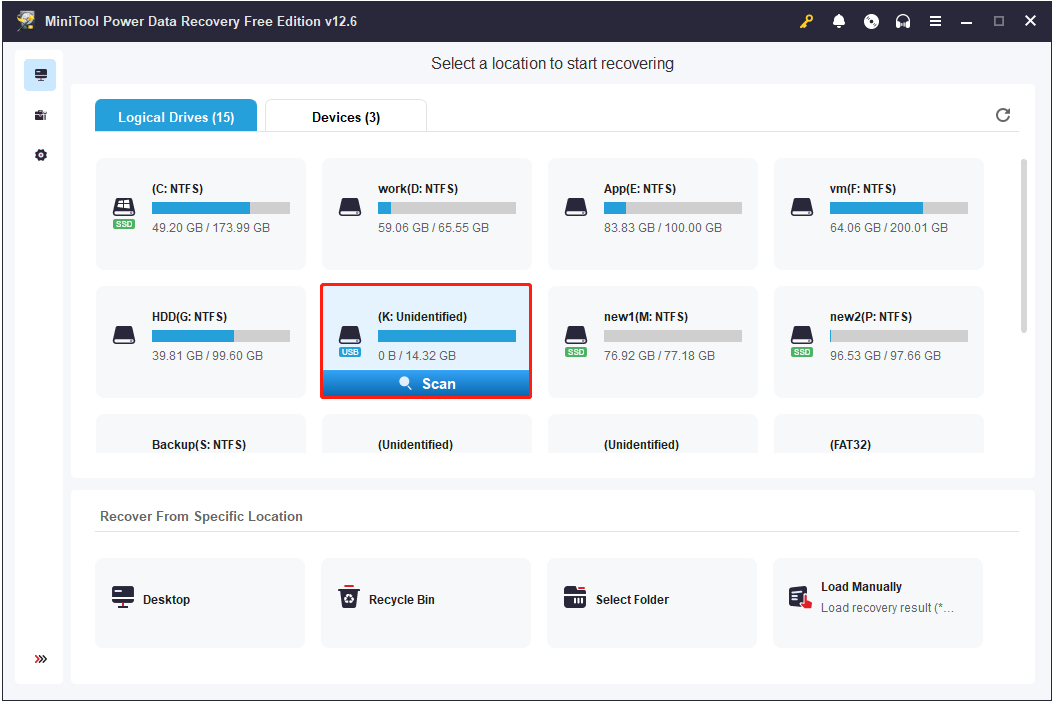
The recovery program will start scanning the selected partition for files. The scan duration depends on the amount of data, disk status, etc. To get the best scan results, wait patiently for it to complete.
Step 2. After scanning, browse through the listed files to find the ones you want to recover, and tick them.
During this process, you can use the following file view options and filtering features:
- Path: Under this tab, files are listed by their original folder structure. Expand each folder to locate the files you want to recover.
- Type: In this section, files are classified by file type and data format. This is very useful if you want to recover a certain type of file.
- Filter: Use this feature to filter out unwanted files by file type, modification date, file size, and file category.
- Search: Type a partial or complete file name in the search box and press Enter to display only matching files.
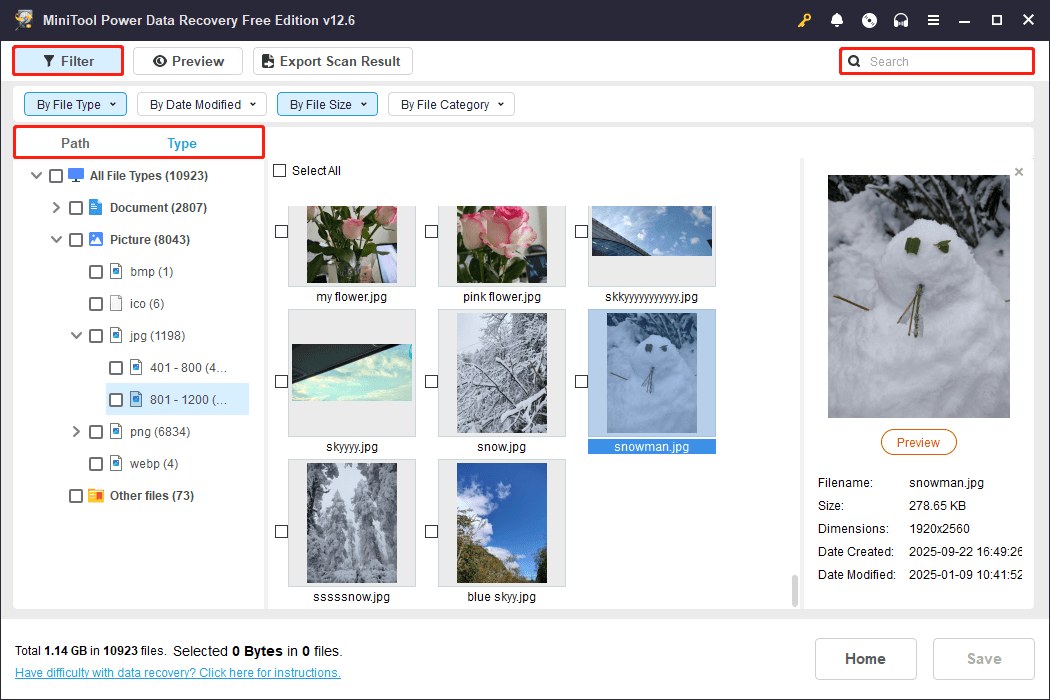
Step 3. Before recovery, double-click each file to preview its content.
Once you have confirmed and selected all the files you want to recover, click Save. In the new window, choose a safe drive or folder to store the recovered files.

When it is done, go to the selected destination to view and use the recovered files.
This is all about how to recover data from a hard drive that says it needs to be formatted. Next, let’s see how to reformat an external hard drive, internal disk, or USB drive.
Action 2. Format the Drive
To format the drive, go to File Explorer, right-click the problematic drive, and choose Format. Then set up the file system, volume label, and other options, and click Start to format the drive.
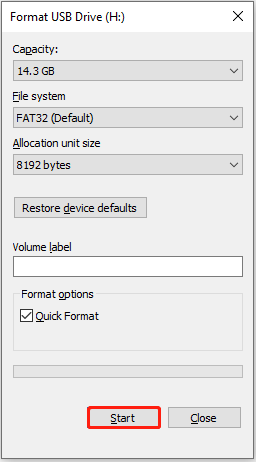
If File Explorer cannot complete the format, try using MiniTool Partition Wizard.
This free partition manager handles corrupted partitions more effectively. Besides, it offers more file system options, including NTFS, FAT32, exFAT, Ext2, Ext3, and Ext4.
Now, download, install, and launch MiniTool Partition Wizard to format your disk.
MiniTool Partition Wizard FreeClick to Download100%Clean & Safe
Step 1. On the main interface of this partition manager, select the unformatted partition, and then click Format Partition from the left action panel.
Step 2. In the new pop-up window, type a partition label, choose a file system, and click OK.

Step 3. Click Apply in the lower left corner to confirm. After that, you can go to File Explorer to use the drive.
Bonus Tip: How to Back Up Files on Windows
After recovering your files and formatting the drive, your storage device should be back to normal. However, to avoid running into similar issues in the future, it is always wise to create regular data backups.
Here are three effective backup options.
Option 1. Copy and Paste Manually
The simplest way to back up important files is to manually copy and paste them to another drive, such as an external hard disk.
This method works well for small amounts of data and is a good choice if you do not want to download any third-party software. However, it can be time-consuming when backing up large files.
Option 2. Use OneDrive, Google Drive, or Dropbox
If you frequently access your files across multiple devices, using cloud storage services may be the most convenient option.
Popular and secure services include OneDrive, Google Drive, Dropbox, and more. Most of these services provide a limited amount of free storage, and you can purchase more space if needed.
Here are the official tutorials:
- Back up your files with OneDrive
- Upload files and folders to Google Drive
- How to set up Dropbox backup
Option 3. Use MiniTool ShadowMaker
If you prefer using professional data backup software, MiniTool ShadowMaker is highly recommended.
Compared with other backup solutions, it is more convenient and flexible. It supports different backup types (full, incremental, and differential) and various schedules (daily, weekly, monthly, when logging on, and when logging off).
This software supports backing up files as well as complete partitions and disks.
If you have not used this tool before, you can download the trial edition and use it for free for 30 days.
MiniTool ShadowMaker TrialClick to Download100%Clean & Safe
Check out this official guide for detailed steps: How to Back Up Files.
Final Thoughts
When your system prompts you to format your disk before using it, do not format it immediately. Start with basic troubleshooting steps, such as reconnecting the drive, running CHKDSK, or scanning for viruses.
If these steps fail to restore your disk, use MiniTool Power Data Recovery to recover your files, and then format the drive.
By the way, in daily disk use, it is important to regularly back up your important data to prevent file loss.
For any issues or questions regarding MiniTool products, please contact the support team at [email protected].
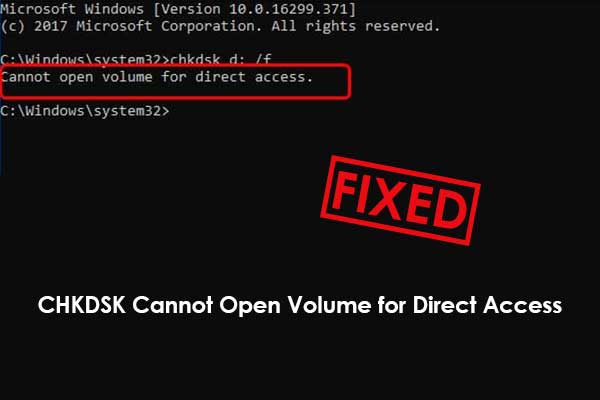
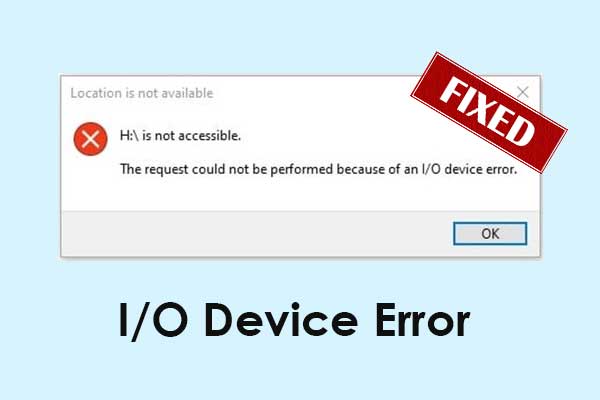

User Comments :